Shortly we boarded our bus and were off to the main
attraction. The Butchart Gardens. (http://www.royaltours.bc.ca/page2.html)
. 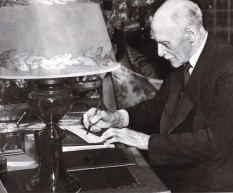 In the
mid 1800 George MacLauchlan Butchart moved his family from the
Forfar District of Scotland, to Owen Sound, Ontario. In 1856
Robert Pim Butchart was born, one of 11 children. Robert grew up
learning the hardware business at his father’s store. He
married Jennie Foster Kennedy, a very adventurous lady who
enjoyed ballooning and flying. She later became a qualified
chemist. On their honeymoon in England, Mr. Butchart learned the
process of the manufacture of Portland cement.
In the
mid 1800 George MacLauchlan Butchart moved his family from the
Forfar District of Scotland, to Owen Sound, Ontario. In 1856
Robert Pim Butchart was born, one of 11 children. Robert grew up
learning the hardware business at his father’s store. He
married Jennie Foster Kennedy, a very adventurous lady who
enjoyed ballooning and flying. She later became a qualified
chemist. On their honeymoon in England, Mr. Butchart learned the
process of the manufacture of Portland cement. 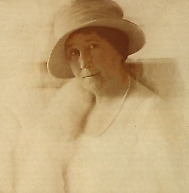 Together with his brother David,
Mr. Butchart pioneered advancements in cement as they introduced
the first sacks of cements rather then the standard barrels that
were common. In 1902 Mr. Butchart came to Vancouver Island, and
located some twelve miles north of Victoria, where he believed
the required limestone could be found. Two years later, the Tod
Inlet cement plant was started and Jennie joined her husband on
Vancouver Island. The West Coast was exploding with development,
and cement was in constant demand from San Francisco to Seattle.
Together with his brother David,
Mr. Butchart pioneered advancements in cement as they introduced
the first sacks of cements rather then the standard barrels that
were common. In 1902 Mr. Butchart came to Vancouver Island, and
located some twelve miles north of Victoria, where he believed
the required limestone could be found. Two years later, the Tod
Inlet cement plant was started and Jennie joined her husband on
Vancouver Island. The West Coast was exploding with development,
and cement was in constant demand from San Francisco to Seattle. 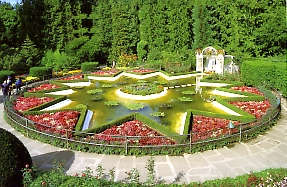 The first sacks of
cement sailed out of Vancouver Island aboard the
“Alexander” in 1905. Jennie Butchart busied herself
around the estate by planting flowers and shrubbery in an area
between the house and Butchart cove, the area that is now the
Japanese Garden. As time passed, Jennie’s efforts increased
and her husband often supplied workmen from the factory to assist
in the ever growing project of gardening.
The first sacks of
cement sailed out of Vancouver Island aboard the
“Alexander” in 1905. Jennie Butchart busied herself
around the estate by planting flowers and shrubbery in an area
between the house and Butchart cove, the area that is now the
Japanese Garden. As time passed, Jennie’s efforts increased
and her husband often supplied workmen from the factory to assist
in the ever growing project of gardening. 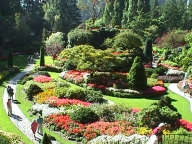 By 1908 the limestone ran out, leaving a
gigantic pit near the house. In an attempt to hide this hideous
excavation, Jennie planted Lombary and white poplars along with
Persian plums between the pit and the house. The concept of a
sunken garden formed, and Jennie had massive amounts of topsoil
imported by horse cart to form the garden bed. The rubble on the
floor of the pit was pushed into tall mounds or rock on which
terraced flowers were planted. The largest tower in the lower
garden supports an observation platform, from which you can see
most of the original pit.
By 1908 the limestone ran out, leaving a
gigantic pit near the house. In an attempt to hide this hideous
excavation, Jennie planted Lombary and white poplars along with
Persian plums between the pit and the house. The concept of a
sunken garden formed, and Jennie had massive amounts of topsoil
imported by horse cart to form the garden bed. The rubble on the
floor of the pit was pushed into tall mounds or rock on which
terraced flowers were planted. The largest tower in the lower
garden supports an observation platform, from which you can see
most of the original pit. 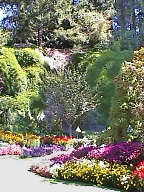 Mrs. Butchart solved the problem of the grim
gray quarry walls by dangling over the side in a boson’s
chair and carefully tucking ivy into any discernible pocket or
crevice in the rock. In 1921, the project was completed. It had
become a garden of immense interest to the surrounding community.
Tales of Mr. and Mrs. Butchart’s fabulous gardens spread as
fast as the gardens themselves. From the beginning, friends,
acquaintances, and even complete strangers were welcomed, as they
came to marvel at the horticultural masterpiece.
Mrs. Butchart solved the problem of the grim
gray quarry walls by dangling over the side in a boson’s
chair and carefully tucking ivy into any discernible pocket or
crevice in the rock. In 1921, the project was completed. It had
become a garden of immense interest to the surrounding community.
Tales of Mr. and Mrs. Butchart’s fabulous gardens spread as
fast as the gardens themselves. From the beginning, friends,
acquaintances, and even complete strangers were welcomed, as they
came to marvel at the horticultural masterpiece. 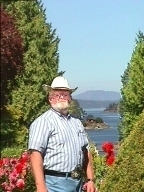 The Butcharts named
their home “Benvenuto”, which is Italian for welcome.
They would serve tea to all that came, invited or uninvited. This
would continue until the sheer number of people arriving made it
impossible. In 1915 alone, it was reported that tea was served to
18,000 people. Mrs. Butchart would, on occasion, serve tea
herself in such a manner that she was sometimes not recognized,
and on one occasion received a tip from a visitor. By 1930,
thousands of people were being attracted to Jennie’s
gardens.
The Butcharts named
their home “Benvenuto”, which is Italian for welcome.
They would serve tea to all that came, invited or uninvited. This
would continue until the sheer number of people arriving made it
impossible. In 1915 alone, it was reported that tea was served to
18,000 people. Mrs. Butchart would, on occasion, serve tea
herself in such a manner that she was sometimes not recognized,
and on one occasion received a tip from a visitor. By 1930,
thousands of people were being attracted to Jennie’s
gardens. 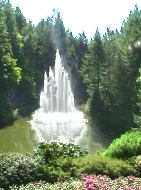 Jennie
emerged into an indefatigable and generous hostess, not only to
her own friends, but to hundreds of visitors to Victoria. In
appreciation of her generosity, in 1930, she was named
Victoria’s best citizen. World War II stripped the area of
available manpower and the garden began to decline. Mr.
Butchart’s failing health caused them to move to Victoria
where Mr. Butchart died in 1943 and his wife in 1950. Their two
daughters, Jennie and Mary continued on as best as possible until
Jennie’s son R. Ian Ross returned from the war. As the
gardens had been left to him by his grandparents.
Jennie
emerged into an indefatigable and generous hostess, not only to
her own friends, but to hundreds of visitors to Victoria. In
appreciation of her generosity, in 1930, she was named
Victoria’s best citizen. World War II stripped the area of
available manpower and the garden began to decline. Mr.
Butchart’s failing health caused them to move to Victoria
where Mr. Butchart died in 1943 and his wife in 1950. Their two
daughters, Jennie and Mary continued on as best as possible until
Jennie’s son R. Ian Ross returned from the war. As the
gardens had been left to him by his grandparents.
 <<<<< Back
Next
>>>>>
<<<<< Back
Next
>>>>> 
 In the
mid 1800 George MacLauchlan Butchart moved his family from the
Forfar District of Scotland, to Owen Sound, Ontario. In 1856
Robert Pim Butchart was born, one of 11 children. Robert grew up
learning the hardware business at his father’s store. He
married Jennie Foster Kennedy, a very adventurous lady who
enjoyed ballooning and flying. She later became a qualified
chemist. On their honeymoon in England, Mr. Butchart learned the
process of the manufacture of Portland cement.
In the
mid 1800 George MacLauchlan Butchart moved his family from the
Forfar District of Scotland, to Owen Sound, Ontario. In 1856
Robert Pim Butchart was born, one of 11 children. Robert grew up
learning the hardware business at his father’s store. He
married Jennie Foster Kennedy, a very adventurous lady who
enjoyed ballooning and flying. She later became a qualified
chemist. On their honeymoon in England, Mr. Butchart learned the
process of the manufacture of Portland cement.  Together with his brother David,
Mr. Butchart pioneered advancements in cement as they introduced
the first sacks of cements rather then the standard barrels that
were common. In 1902 Mr. Butchart came to Vancouver Island, and
located some twelve miles north of Victoria, where he believed
the required limestone could be found. Two years later, the Tod
Inlet cement plant was started and Jennie joined her husband on
Vancouver Island. The West Coast was exploding with development,
and cement was in constant demand from San Francisco to Seattle.
Together with his brother David,
Mr. Butchart pioneered advancements in cement as they introduced
the first sacks of cements rather then the standard barrels that
were common. In 1902 Mr. Butchart came to Vancouver Island, and
located some twelve miles north of Victoria, where he believed
the required limestone could be found. Two years later, the Tod
Inlet cement plant was started and Jennie joined her husband on
Vancouver Island. The West Coast was exploding with development,
and cement was in constant demand from San Francisco to Seattle.  The first sacks of
cement sailed out of Vancouver Island aboard the
“Alexander” in 1905. Jennie Butchart busied herself
around the estate by planting flowers and shrubbery in an area
between the house and Butchart cove, the area that is now the
Japanese Garden. As time passed, Jennie’s efforts increased
and her husband often supplied workmen from the factory to assist
in the ever growing project of gardening.
The first sacks of
cement sailed out of Vancouver Island aboard the
“Alexander” in 1905. Jennie Butchart busied herself
around the estate by planting flowers and shrubbery in an area
between the house and Butchart cove, the area that is now the
Japanese Garden. As time passed, Jennie’s efforts increased
and her husband often supplied workmen from the factory to assist
in the ever growing project of gardening.  By 1908 the limestone ran out, leaving a
gigantic pit near the house. In an attempt to hide this hideous
excavation, Jennie planted Lombary and white poplars along with
Persian plums between the pit and the house. The concept of a
sunken garden formed, and Jennie had massive amounts of topsoil
imported by horse cart to form the garden bed. The rubble on the
floor of the pit was pushed into tall mounds or rock on which
terraced flowers were planted. The largest tower in the lower
garden supports an observation platform, from which you can see
most of the original pit.
By 1908 the limestone ran out, leaving a
gigantic pit near the house. In an attempt to hide this hideous
excavation, Jennie planted Lombary and white poplars along with
Persian plums between the pit and the house. The concept of a
sunken garden formed, and Jennie had massive amounts of topsoil
imported by horse cart to form the garden bed. The rubble on the
floor of the pit was pushed into tall mounds or rock on which
terraced flowers were planted. The largest tower in the lower
garden supports an observation platform, from which you can see
most of the original pit.  Mrs. Butchart solved the problem of the grim
gray quarry walls by dangling over the side in a boson’s
chair and carefully tucking ivy into any discernible pocket or
crevice in the rock. In 1921, the project was completed. It had
become a garden of immense interest to the surrounding community.
Tales of Mr. and Mrs. Butchart’s fabulous gardens spread as
fast as the gardens themselves. From the beginning, friends,
acquaintances, and even complete strangers were welcomed, as they
came to marvel at the horticultural masterpiece.
Mrs. Butchart solved the problem of the grim
gray quarry walls by dangling over the side in a boson’s
chair and carefully tucking ivy into any discernible pocket or
crevice in the rock. In 1921, the project was completed. It had
become a garden of immense interest to the surrounding community.
Tales of Mr. and Mrs. Butchart’s fabulous gardens spread as
fast as the gardens themselves. From the beginning, friends,
acquaintances, and even complete strangers were welcomed, as they
came to marvel at the horticultural masterpiece.  The Butcharts named
their home “Benvenuto”, which is Italian for welcome.
They would serve tea to all that came, invited or uninvited. This
would continue until the sheer number of people arriving made it
impossible. In 1915 alone, it was reported that tea was served to
18,000 people. Mrs. Butchart would, on occasion, serve tea
herself in such a manner that she was sometimes not recognized,
and on one occasion received a tip from a visitor. By 1930,
thousands of people were being attracted to Jennie’s
gardens.
The Butcharts named
their home “Benvenuto”, which is Italian for welcome.
They would serve tea to all that came, invited or uninvited. This
would continue until the sheer number of people arriving made it
impossible. In 1915 alone, it was reported that tea was served to
18,000 people. Mrs. Butchart would, on occasion, serve tea
herself in such a manner that she was sometimes not recognized,
and on one occasion received a tip from a visitor. By 1930,
thousands of people were being attracted to Jennie’s
gardens.  Jennie
emerged into an indefatigable and generous hostess, not only to
her own friends, but to hundreds of visitors to Victoria. In
appreciation of her generosity, in 1930, she was named
Victoria’s best citizen. World War II stripped the area of
available manpower and the garden began to decline. Mr.
Butchart’s failing health caused them to move to Victoria
where Mr. Butchart died in 1943 and his wife in 1950. Their two
daughters, Jennie and Mary continued on as best as possible until
Jennie’s son R. Ian Ross returned from the war. As the
gardens had been left to him by his grandparents.
Jennie
emerged into an indefatigable and generous hostess, not only to
her own friends, but to hundreds of visitors to Victoria. In
appreciation of her generosity, in 1930, she was named
Victoria’s best citizen. World War II stripped the area of
available manpower and the garden began to decline. Mr.
Butchart’s failing health caused them to move to Victoria
where Mr. Butchart died in 1943 and his wife in 1950. Their two
daughters, Jennie and Mary continued on as best as possible until
Jennie’s son R. Ian Ross returned from the war. As the
gardens had been left to him by his grandparents. 